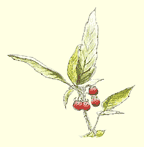Get Berry Ready for Summer, Starting Now
February pruning brings luscious warm-weather berries
Winter pruning of small-fruit crops like raspberries, black caps, blackberries, blueberries and grapes can begin as early as February.
Raspberries: If you are growing the biennial cane cultivars of raspberries — Latham, Heritage or Supreme — prune out all canes that produced fruit last summer. Then, thin out the remaining canes so they are spaced four to five inches apart. To harvest not one but two crops from cane of Heritage this summer, remove only the top half of the cane that fruited as soon as it finishes its first fruiting. This cane will then produce side shoots that will flower and fruit again in late summer. If the new cane produces only a late summer or early fall crop, remove just the upper half of the cane now. That forces the cane to produce early-summer shoots.
If you are up to date and growing only primary cane raspberries, delay pruning to the ground until mid-March. Pruning primary cane raspberries early increases the risk of losing your plants to very cold temperatures.
Blackcaps: Blackcaps or black raspberries are pruned similarly to the old cultivars of raspberries. First remove all of the canes that fruited last year; then thin the remaining stems four to five inches apart.
Blackberries: Unless you prune back most thornless blackberry plants, you will need a stepladder to harvest the berries. Prune blackberry plants by cutting the older woody canes close to the ground. Also remove canes smaller than a pencil in diameter. Some of the thornless cultivars are extremely vigorous, and the tops of the canes must be pruned to four feet from the ground.
Blueberries: Branches producing blueberries this year are either reddish or yellowish in color, depending on cultivars. Select three to five of the best small branches with the largest and fattest buds on each stem and prune away all of the other branches. You’ll get bigger blueberries if you prune to the recommended number of small branches on each stem. Avoid stooping low next summer when harvesting by pruning away all small branches less than three feet above the ground. The remaining, bigger stems will grow tall and strong.
Ask Dr. Gouin your questions at [email protected]. All questions will appear in Bay Weekly. Please include your name and address.